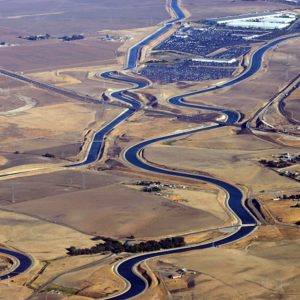Coloradans who pay close attention to western water issues have monitored California’s internal water wars for years. Leaders there have worked for decades to address long-term water shortages for farms in the San Juaquin Valley, while their giant metropolitan cities continue to grow, and while trying to leave as much water in the rivers as possible for the endangered “Delta smelt.” Like every western state, California has very limited water, so how they divvy it up quite literally determines which areas grow and prosper, and which areas do not.
 For the most part, other westerners try to stay out of internal battles within California, a favor we hope Californians would return. But we also keep a close eye out for any change that could affect our own water supplies in the upstream states, ever vigilant to protect the delicate agreements that manage allocations of the Colorado River. Colorado and the other six states were actively engaged for more than a decade, for instance, in the 2003 agreement to wean that State from its reliance on surplus flows, and return California to its annual 4.4 million acre-foot allotment. To accomplish that, southern California had to quantify its water rights (which had not been required), and reduce water use by its oldest irrigation districts, especially in the Imperial Valley.
For the most part, other westerners try to stay out of internal battles within California, a favor we hope Californians would return. But we also keep a close eye out for any change that could affect our own water supplies in the upstream states, ever vigilant to protect the delicate agreements that manage allocations of the Colorado River. Colorado and the other six states were actively engaged for more than a decade, for instance, in the 2003 agreement to wean that State from its reliance on surplus flows, and return California to its annual 4.4 million acre-foot allotment. To accomplish that, southern California had to quantify its water rights (which had not been required), and reduce water use by its oldest irrigation districts, especially in the Imperial Valley.
The other states didn’t care so much how California water leaders reduced their internal use of Colorado River water, as long as they did so, meeting certain required milestones along the way. Their internal struggle was expensive and painful. But it also focused increased attention on northern California, because while much of the Los Angeles water supply comes from the Colorado River, the rest comes mostly from the “State Water Project.”
That system of reservoirs, aqueducts, and pumping stations extends over two-thirds the length of California, supplying water to 27 million people, including the Bay Area, the San Joaquin Valley, the Central Coast and Southern California, including L.A. and San Diego. It also irrigates 750,000 acres of farmland in the San Joaquin Valley, which is the crux of the problem. More water for the cities means less water for irrigation – and more water for endangered fish means less water for either.
The primary issue is the management of reservoirs and diversions from the Sacramento-San Joaquin Delta. It is complicated by the fact that the State runs its own elaborate system, essentially parallel to the federal government’s “Central Valley Project,” owned and operated by the Interior Department. The former supplies massive amounts of water to the big thirsty cities, and the latter to most of the agriculture in the Central Valley – which produces more than half the fruits and vegetables grown in the United States. Both projects take water from the Sacramento-San Joaquin Delta, so the state and federal governments negotiated a Coordinated Operation Agreement in the 1980s, defining how the two water projects meet water needs, while complying with environmental laws, and with court rulings about the Delta smelt. That agreement called for periodic reviews, which began in 2016 and is not yet resolved.
It is difficult to overstate the difficulty, and importance, of balancing those limited supplies between agriculture that supports the entire nation, some of the country’s largest and most important cities, and the vital habitat for important species. Yet it remains largely an internal problem for California, and a complex negotiation between that State and the federal government. Except for one detail that has Colorado water leaders on edge.
On his way out of office in 2018, Governor Jerry Brown negotiated a final deal that seemed likely to get all the competing interests on the same page, and incoming Governor Gavin Newsom endorsed it. In the fine print, though, the Metropolitan Water District of Southern California, the most powerful water entity in the West, quietly gave the feds a significant share of its own water, during extremely dry years. That matters to Colorado because if Los Angeles ever finds itself short of water because of that little detail, it has but one other place to turn – the Colorado River.
Environmental groups have gone off-script, demanding more water for fish, and Newsom now waffles on it, so final implementation is uncertain. But if future water shortages cause L.A. to demand more water from the Colorado River, it would reopen the most difficult and delicate compromise in a century, with the outcome uncertain, at best. In other words, California’s internal water battle is none of our business – until it is.
This column originally appeared in the Grand Junction Daily Sentinel March 20, 2020.




Comments on this entry are closed.